The flame of Darvaza
The flame of Darvaza, text and photos by
Juza. Published on 17 Agosto 2013; 5 replies, 16759 views.
There are three craters: water, earth and fire. The three sacred elements in the myths of the ancient populations that lived in the Karakum. But none of these craters has natural nor supernatural origin: all of them have been created by the fight of humans against the elements. It all begun with drilling to extract gas; in the first crater, the drill hit an underground torrent and the water flooded everything, making impossible to extract gas.
In the second crater, the ground slided down, three persons died and the crater was filled with boiling mud. The third crater is a giant ring of fire. It is unknown if everything just collapsed or if there was a small sparkle that lightened up the caves of gas under Darvaza, but since then the crater has never stopped shining, and it burns, burns, burns.

A dream of fire
Weird, remote and little know places have always fascinated me. Some years ago I read for the first time about a fire crater that kept burning for decades, it captured so much my imagination that I have ever dreamt about it. But it was far away from my country, so initially I did not plan to visit it; nevertheless, it always remained somewhere in my mind, waiting for something that would have relived my desire to see this amazing place.
For me, the wake-up call was on 15 February 2013, the day of the meteor strike above Russia. Few hour later, a second asteroid zipped close to the heart, even though this time it did not explode. The probabilities of two events like that happening in the same day where less than one in a billion, but it happened. Even though the meteor strike is not related in any way with the Darvaza crater, it was something so incredible and fascinating that gave me the inspiration and desire to see with my eyes another incredible thing of our world... the flaming crater.
I searched for everything that I could read about this place. Not much: there are many articles about it, but they are mostly coping and pasting the same things. There are no detailed reports about the story of this crater; it happened when Turkmenistan was still a part of Soviet Union, and URSS has never been eager to publish detailed reports of accidents. But I found what I needed: the exact location of this place and a name to contact. Indeed, Turkmenistan is very closed to tourism, and it is not possible to visit it by yourself, you have to request a letter of invite to a local agency; once approved, you will get the permission to visit some places of this country, with a guide/escort that will always follow you.
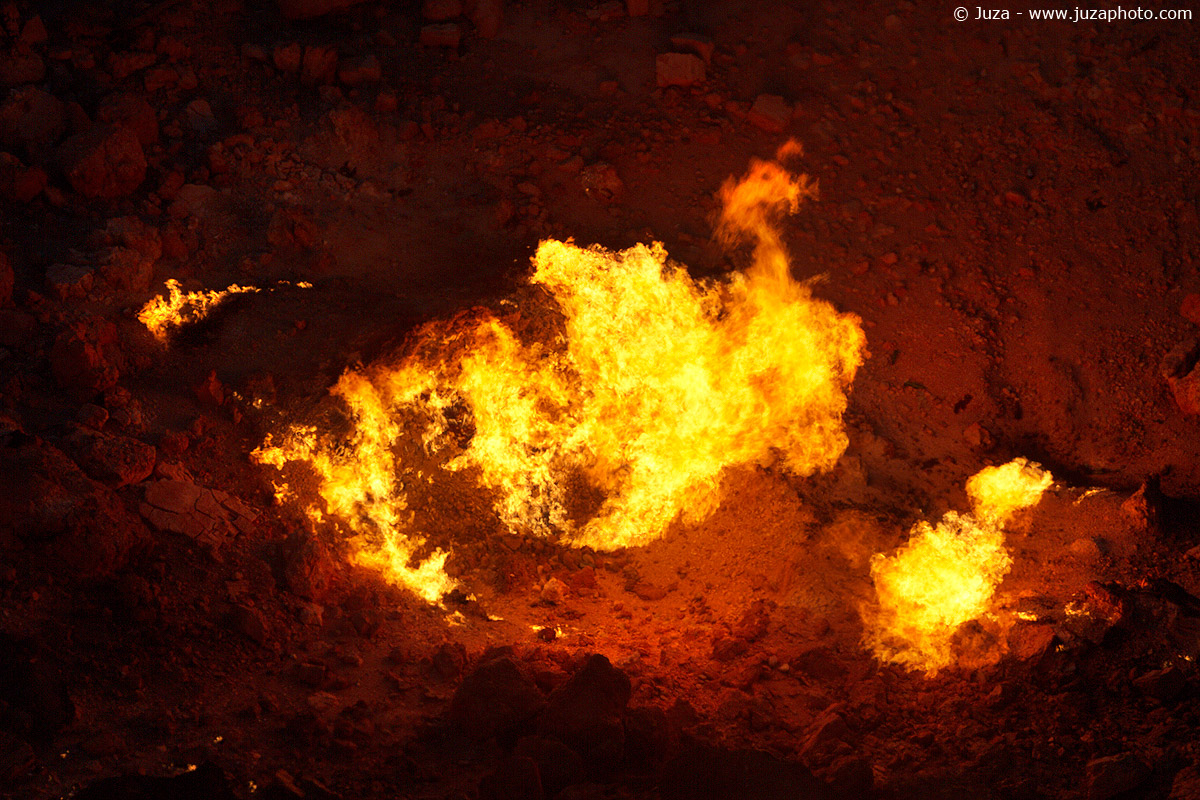
I wrote a letter to the agency explaining my fascination for Darvaza, and after about one week Musa replied to me. My path toward the flaming crater had begun. Placed between Iran and Afghanistan, the Turkmenistan is not exactly a popular touristic destination, nevertheless I found three travelmates is few days. Unsurprisingly, they where three persons that shared my passion for unusual and mysterious places, without fears for the difficulties or the risks that a trip like that may have.
I am grateful to all the persons who shared with me this adventure. Andrei, Pier, Sergio, our guide Murad, Aman, Vladimir, Musa...all them have proved to be genuinely great persons that have contributed to this trip in many different ways.
The City of White Marble

The weirdness of this country begins for the capital itself, Ashgabat. This is the only city of the world with more than 500 huge buildings made by... marble. Most of these buildings are quite recent, they have been built under the president for life Gurbanguly Berdimuhamedow, who rules the country since 2006. Turkmenistan is so rich of natural gas and oil that it has been able to spend billions and billions or dollars to create a city that seems to be made for giants, not for humans: between the palaces of marble, in the large streets, there are very few persons around. This country is almost twice as big than Italy, but it has only five million of inhabitants, about one million lives in the immense capital city and the other four millions are scattered around the country. Vast desert areas an completely uninhabited.
For some aspects the society of Turkmenistan is more 'open-minded' than what you could expect. While walking in Ashgabat, we expected so see women covered with burka, instead with our great surprise we saw a much more "emancipated" look: girls walked around with colorful, characteristic clothes. Their somatic traits are a mix between Russian, Caucasian and Arab. They are beautiful; even older women look graceful.
Living in a country rich of gas and oil as Turkmenistan has some advantages: you get 120 liters of fuel for free every month, and if you need more, the price is equivalent to about 0.15 euro/liter for unleaded 95; gas and electricity are free. The quality of life has improved a lot in the latest twenty years; in nineties a guide as Murad earned about 20$ per month, nowadays it can get close to one thousand dollars.
On the other side, ADSL access to Internet is very expensive, and very few persons can afford it. Many websites, including some social networks and popular websites as Youtube, are blocked. Turkmenistan is ranked 178 in the Press Freedom Index, with only North Korea and Eritrea having a lower rank.
I don't know how accurate is that estimate. We had not much chances to talk with the citizens of Ashgabat; English language is rarely understood, and I did not know anything in Russian or Turkmen. We left the city in mid afternoon; few kilometer out of Ashgabat, the road begun to breack up, and our two Toyota Land Cruisers keps jumping on the huge bumps. The sandy soil does not prove a stable support, so the asphalt quickly becomes very rough. We were in route towards Darvaza, at more than 250 kilometers from the capital, in the middle of Karakum Desert.
The Three Craters
Darvaza is not even the name of the crater. Darvaza, or Derweze, was a village of about 300 persons, near some drilling sites. Three of these collapsed; the fire crater is now called with the name of the abandoned village.

It is not the only ghost village: on the road to the crater, we saw a sign "Airport". Soviet geologist built here a small airport, and the nearby village was nicknamed that way, until 'Airport' became its ufficial name. Nowaday, like Darvaza, the village of Airport no longer exists. What exactly happened here?
Information is scarce. We know that this story begins 40 years ago. Soviet geologists were drilling in the Darvaza area, a place with abundant natural gas. They hit the roof of an huge cavern, the ground collapsed (or exploded, it is not clear) and the result was an huge crater and an endless flow of poisonous gas (methane) coming out. Since it was not possible to close the 70 meters crater, they set fire to the gas by throwing a bomb into the crater, hoping that it will burn in few days. It was 1971, and the gas is still burning today, an eternal flame that burns brightly in the middle of Karakum desert.
It has been called 'Gates to Hell', 'Hell's Doors' and so on, because the name of the little nearby village, Darvaza, means 'the gate' in Turkmen language. The reference to hell does not need much explanation, just look at the photos and imagine the smell of gas all around the crates, the temperatures well above 40 celsius degrees and the eternal flames...
It is not a beautiful place in the conventional meaning of this word, but it is one of the incredible oddities of our planet. The Karakum is a large, almost uninhabited area; it is one of the most inhospitable places on the planet. This place is so remote, and the country has such abundance of gas, that nobody really tried to close the crater.

Nothing can prepare you to the spectacle that you will see at Darvaza. It is otherworldly. The crater is about 70 meters wide and 30 meters deep: flames came out everywhere on the sides of the crater, and an huge flame that looks like a spiral of fire, ten meters wide, comes out from the center of the crater. Imagine how much gas can come out from a 70 meters hole, and imagine all that gas on fire. It is unbelievable. The air near the crater is very hot and there is a strong smell of gas; on windy days the gusts of wind bring the hot gas out of the crater for dozens of meters. Many times while I was standing close to the crater (you can even stay at few centimeters from the edge) I had to run away quickly because in few instants the air become saturated with gas that made impossible to breathe and burnt the skin.
The sides of the crater are made mainly by black, burnt ground; on one side you can still see some broken pipes hanging out. All around the 'gate of hell' there is a barren landscape, mostly flat except for some small hills...it looks like a Martian landscape. I spent hours watching that eternal flame that never stop burning, it was mesmerizing.
We spent here one night, and after sunset the crater brightened up the sky with a light that could be seen from miles of distance.
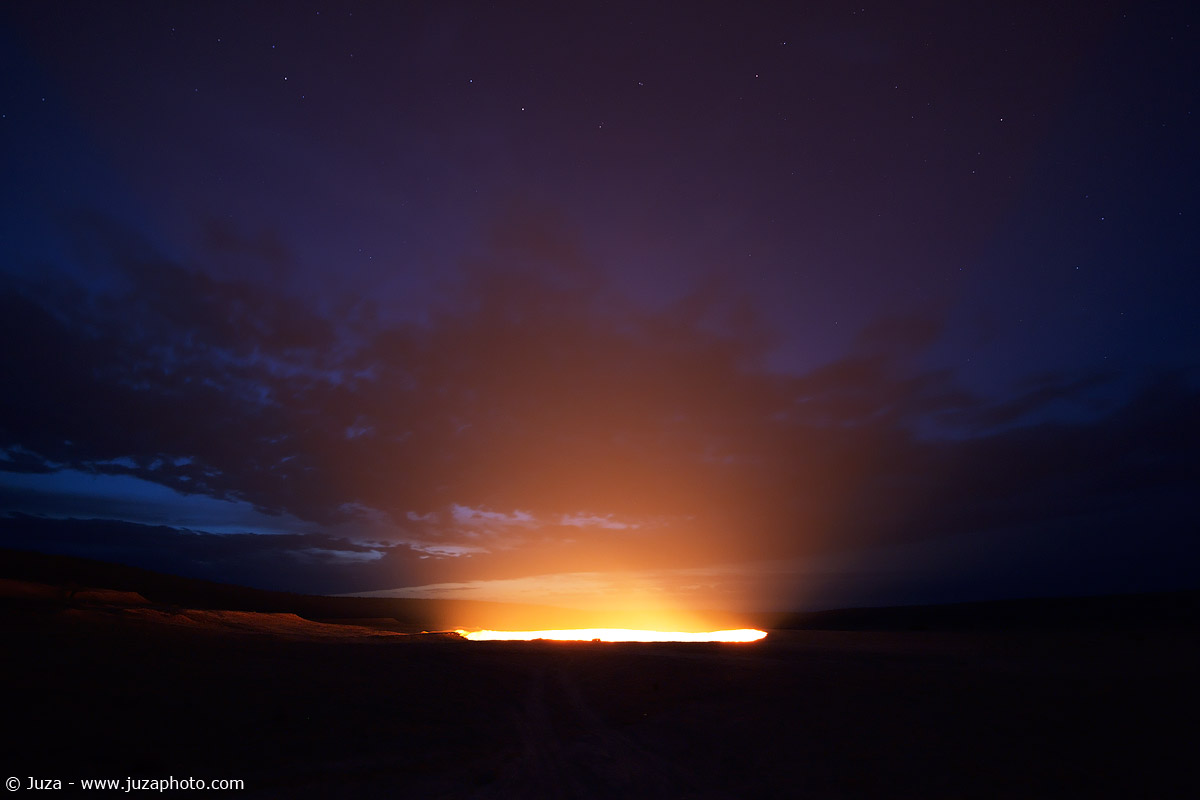
Damla in the desert
I spent the first hours of the morning just watching the flaming crater. I knew that it was something unique and maybe I'd have never seen it again in my life, so I was trying to capture as much as I could with my eyes, I was trying to carve it in my memory.
After a small breakfast we said goodbye to Darvaza and we headed towards Damla, a lonely village in the Kararum desert. The desert was literally shining. We asked to Murad what is it, and he stopped the car so we could get out and look by ourselves. There were crystals of quartz everywhere, as far as the eye can see, and they all reflected the sunlight...another amazing view of this little known country.
It was early afternoon when we reach Damla. This village is so small and unknown that it does not even appear on maps; after coming back from the trip I have spent days searching it but I haven't been able to find the coordinates. We were invited to have lunch in a yurt, a structure of wood used as house by the nomads of central Asia. The yurt was decorated with many carpets, where we sit for lunch; no chairs here. The food was placed in the center of the yurt and we eat together with Hadji, the head of the village, and one of his grandsons, a cute three years old child. Sometimes other children gave a glance inside to see the foreigners...they did not see often people from other countries.

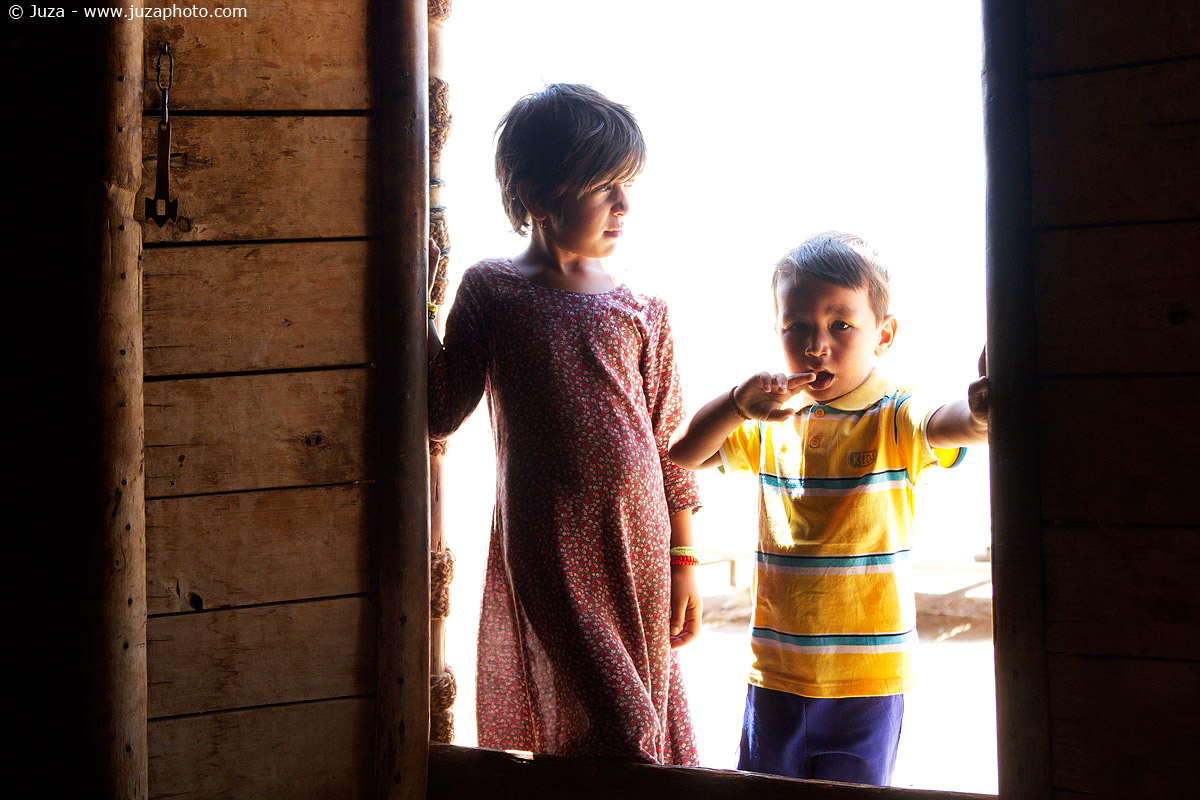
The heat in the afternoon was really too much for us, so we rested a bit in Hadji's house. Andrei, our travel mate from Hungary, immediately fell asleep, while me, Sergio and Pier spent the afternoon talking about our lives. I had never met these guys before this trip, but we are all adventurous travelers with several passion in common, so we easily found topics for discussion.
When the sun begun to head down, and the temperature become a bit less scorching, I wandered around in the village to take some photos of people. Kids were more than happy to be photographed, but even many adults smiled in front of my camera. Two girls invited me to follow them to the well, located at a couple hundred meters from the village. Since there is no running water, women keep walking back and forth the well with heavy buckets of water, while the men follow the flocks with old motorcycles or rest in the yurts. The girls of Damla are slender and athletic; most of them have long, dark hairs and they dress beautiful clothes made by themselves.

Near the well there was also a small puddle of water where dromedaries and other animals can drink. The girls kept chatting while they filled their buckets, then they headed back to the village, a essential 'ritual' that was repeated many times per day, every day.
Gonur Depe
There were almost 500 kilometers between Damla and Gonur Depe, an archeological site in the east of Karakum desert, the next destination on our list. In the desert, five hundreds kilometers means at least two days of driving, so we had to spend one night in the middle of nowhere. We camped at about fifty meters from the trail; Aman and Vladimir parked the two Land Cruisers in front of each other and we set up a small fire. Both these guys were fascinating characters. They were not just our drivers, they were also our escort, good cooks and friendly travel mates; Vladimir was a classic Russian - blond hair, massive and a big passion for Vodka. Aman looked like a mix between a KGB agent and Rambo, he had dark short hairs, black sunglasses, camouflaged suit and a long knife on his belt; he was quite skinny, but he lookes like an unbeatable fighter. In the past, both worked as snake hunters and they knew well the hostile desert environment.
Murad, the guide, was the only one who spoke fluent English; he had lived for a couple of years in United Kingdom and he loved to talk about everything, from his personal life to the ancient history of Turkmenistan; from football to art and music. He was also a guitarist and a good singer, and after dinner we all sit down around fire and listen Murad singing Russian songs.
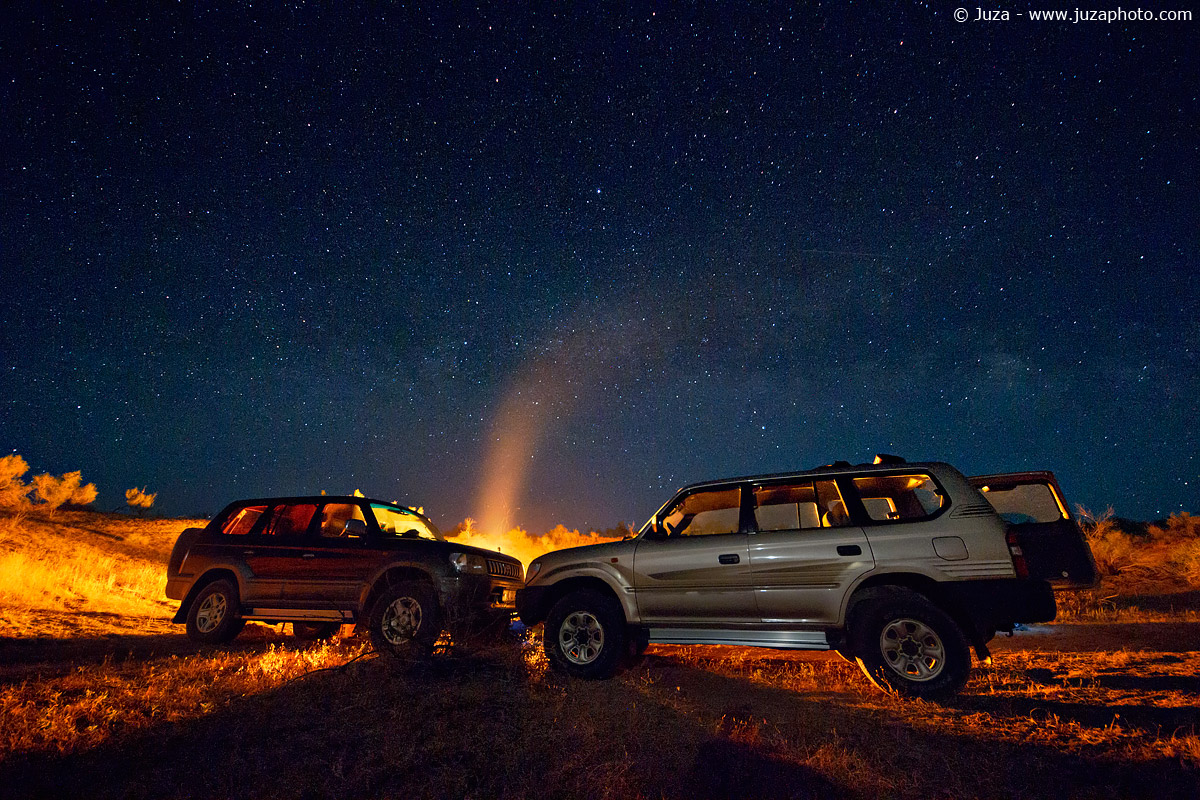
The day after we reached Gonur Depe. This place was discovered in 1972 by an archaeologist that spent the following forty years of his life to explore and to dig the site; nowadays the archaeologist is 94 years old, but he still spend several month every year at Gonur Depe. It is a lonely place; like other area in the desert it has no running water nor electricity and the only house is the one used by the guardian.
There are no fences nor trails; everyone can explore the ancient ruins as he prefers. This is possible because there are only one hundred travelers that come here every year. I don't think that Gonur Depe could survive to mass tourism - the ruins are made of dried mud, and they have lasted two thousands of years only because they were completely covered of sand. They looks extremely fragile, and indeed just stepping on a 'wall' may destroy it. Only the loneliness of this place has saved it. We visited it at sunset, and of course there was not anybody else, except for the dog of the guardian, that followed us. It was difficult to imagine this place in its past glory; 2700 years ago people lived here, but nowadays the ruins were just a pale shadow of that time.

Our base camp was under a shed of asbestos; this carcinogen material is still very common in the small villages of Turkmenistan. There are a couple of dirty tables and our Toyotas, plus the carpet to rest on the ground. Vladimir and Aman had cooked some meat and a truly delicious mashed potatoes. They have also prepared a weird kind of herbal tea made with the so-called 'Camel Grass', and herb that lives in the desert. The put the grass in a metal pot, fill it with water and then they put it directly in the fire until the water boils. With two sticks, they removed the pot from fire. The resulting 'tea' has a smell of rotten onions and an even worse taste, but here it seems to be very popular, Aman and Vladimir happily drink it.
There is a little story without much importance that nevertheless remains in my memories of Gonur Depe. Under the shed of asbestos there were several nests. On the morning of the sixth day of travel, I saw a chick that had fallen from the nest to the hard floor of dry mud. It was heartbreaking because it was still alive and it was slowly moving its beak and his 'wings' (it was really young so it still not have feathers and the eyes were still closed), but when I got close I realized that there was nothing that could have saved it. Bringing it back in the nest wouldn't have helped (it was too injured) and it would have deprived the ants, insects and other animals of a precious source of food, a rare thing in the desert. The little bird died few minutes later. Poor little fella, I thought: its live lasted only a couple of days, and it hadn't even a chance to see the world. But now it was as all the dead: equal. Animals, plants and persons; great conquerors and desperate beggars; kings and slaves who lived before us... now they are all the same... dust. It must be bad to not exist, to be nothing. Maybe that's way we humans have thrived even in the most hostile places; because, after all, even an hard life in the desert is better than the death.
I thought again to Damla and the other remote villages that we visited. The temperature during the day is well above 40 celsius degrees, while during the night it drops under 20 degrees. No tap water, no electricity, almost no contact with the buzzing rest of the world. But they were smiling.
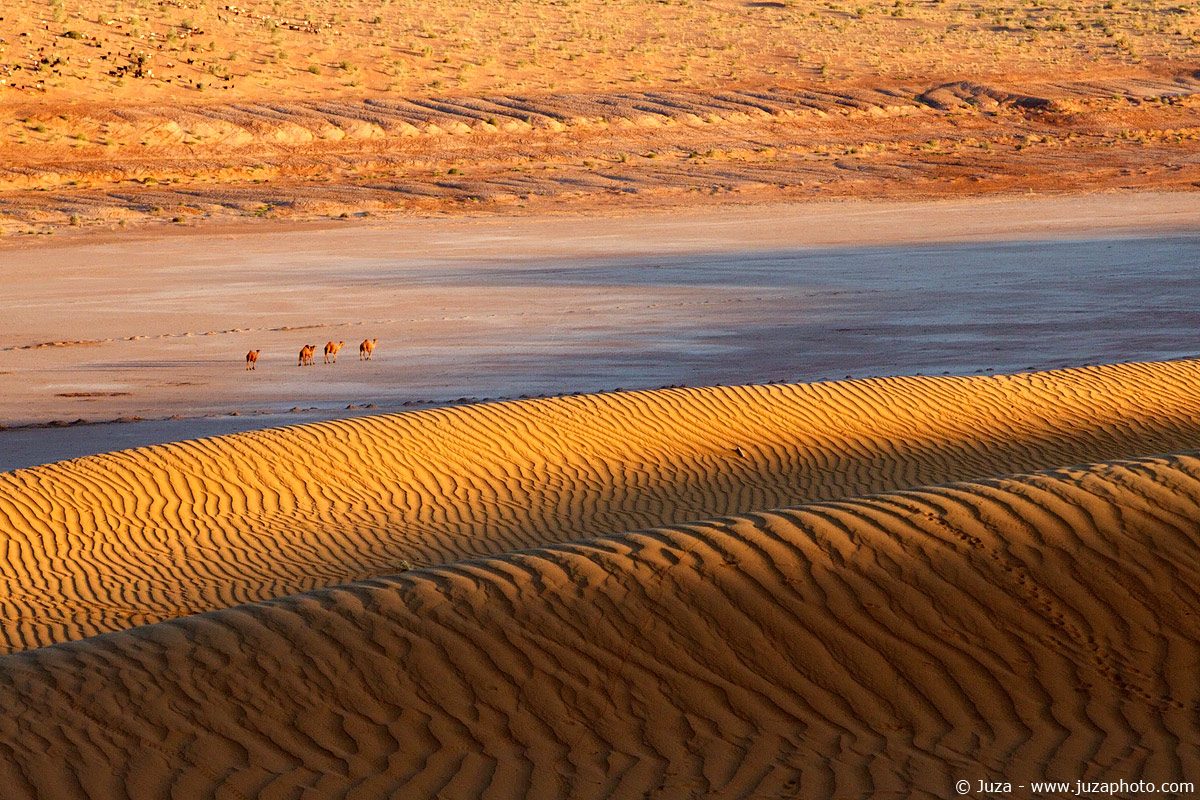
Replies and comments
What do you think about this article?
Do you want to tell your opinion, ask questions to the author, or simply congratulate on a particularly interesting article?
You can join the discussion by joining JuzaPhoto, it is easy and free!
There is more: by registering you can create your personal page, publish photos, receive comments, join discussions and you can use all the features of JuzaPhoto.
With more than 257000 members, there is space for everyone, from the beginner to the professional.
|
|
sent on 18 Agosto 2013 (20:55)
Very good (and uncommon) choice of destination.
The report is very interesting and well illustrated.
My Congratulations
Olivier |
|
|
sent on 19 Agosto 2013 (10:43)
Very nice to read :)
pity so few pictures ... i especially wonder how does the ruins looks like.
Good Job as always |
|
|
sent on 20 Agosto 2013 (1:04)
Fantastic report Juza...I didn't know this place and I must admit you made me want to go and feel the Earth breath...As you did with Norway....thanks..and cheers !  |

 JuzaPhoto contains affiliate links from Amazon and Ebay and JuzaPhoto earn a commission in case of purchase through affiliate links.
JuzaPhoto contains affiliate links from Amazon and Ebay and JuzaPhoto earn a commission in case of purchase through affiliate links.